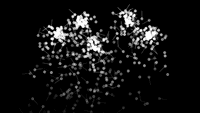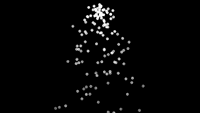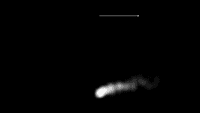Examples+
Flocking
by Daniel Shiffman
An implementation of Craig Reynold's Boids program to simulate the flocking behavior of birds. Each boid steers itself based on rules of avoidance, alignment, and coherence. Click the mouse to add a new boid.
/**
* Flocking
* by Daniel Shiffman.
*
* An implementation of Craig Reynold's Boids program to simulate
* the flocking behavior of birds. Each boid steers itself based on
* rules of avoidance, alignment, and coherence.
*
* Click the mouse to add a new boid.
*/
Flock flock;
void setup() {
size(640, 360);
flock = new Flock();
// Add an initial set of boids into the system
for (int i = 0; i < 150; i++) {
flock.addBoid(new Boid(width/2,height/2));
}
}
void draw() {
background(50);
flock.run();
}
// Add a new boid into the System
void mousePressed() {
flock.addBoid(new Boid(mouseX,mouseY));
}
// The Boid class
class Boid {
PVector position;
PVector velocity;
PVector acceleration;
float r;
float maxforce; // Maximum steering force
float maxspeed; // Maximum speed
Boid(float x, float y) {
acceleration = new PVector(0, 0);
// This is a new PVector method not yet implemented in JS
// velocity = PVector.random2D();
// Leaving the code temporarily this way so that this example runs in JS
float angle = random(TWO_PI);
velocity = new PVector(cos(angle), sin(angle));
position = new PVector(x, y);
r = 2.0;
maxspeed = 2;
maxforce = 0.03;
}
void run(ArrayList<Boid> boids) {
flock(boids);
update();
borders();
render();
}
void applyForce(PVector force) {
// We could add mass here if we want A = F / M
acceleration.add(force);
}
// We accumulate a new acceleration each time based on three rules
void flock(ArrayList<Boid> boids) {
PVector sep = separate(boids); // Separation
PVector ali = align(boids); // Alignment
PVector coh = cohesion(boids); // Cohesion
// Arbitrarily weight these forces
sep.mult(1.5);
ali.mult(1.0);
coh.mult(1.0);
// Add the force vectors to acceleration
applyForce(sep);
applyForce(ali);
applyForce(coh);
}
// Method to update position
void update() {
// Update velocity
velocity.add(acceleration);
// Limit speed
velocity.limit(maxspeed);
position.add(velocity);
// Reset accelertion to 0 each cycle
acceleration.mult(0);
}
// A method that calculates and applies a steering force towards a target
// STEER = DESIRED MINUS VELOCITY
PVector seek(PVector target) {
PVector desired = PVector.sub(target, position); // A vector pointing from the position to the target
// Scale to maximum speed
desired.normalize();
desired.mult(maxspeed);
// Above two lines of code below could be condensed with new PVector setMag() method
// Not using this method until Processing.js catches up
// desired.setMag(maxspeed);
// Steering = Desired minus Velocity
PVector steer = PVector.sub(desired, velocity);
steer.limit(maxforce); // Limit to maximum steering force
return steer;
}
void render() {
// Draw a triangle rotated in the direction of velocity
float theta = velocity.heading2D() + radians(90);
// heading2D() above is now heading() but leaving old syntax until Processing.js catches up
fill(200, 100);
stroke(255);
pushMatrix();
translate(position.x, position.y);
rotate(theta);
beginShape(TRIANGLES);
vertex(0, -r*2);
vertex(-r, r*2);
vertex(r, r*2);
endShape();
popMatrix();
}
// Wraparound
void borders() {
if (position.x < -r) position.x = width+r;
if (position.y < -r) position.y = height+r;
if (position.x > width+r) position.x = -r;
if (position.y > height+r) position.y = -r;
}
// Separation
// Method checks for nearby boids and steers away
PVector separate (ArrayList<Boid> boids) {
float desiredseparation = 25.0f;
PVector steer = new PVector(0, 0, 0);
int count = 0;
// For every boid in the system, check if it's too close
for (Boid other : boids) {
float d = PVector.dist(position, other.position);
// If the distance is greater than 0 and less than an arbitrary amount (0 when you are yourself)
if ((d > 0) && (d < desiredseparation)) {
// Calculate vector pointing away from neighbor
PVector diff = PVector.sub(position, other.position);
diff.normalize();
diff.div(d); // Weight by distance
steer.add(diff);
count++; // Keep track of how many
}
}
// Average -- divide by how many
if (count > 0) {
steer.div((float)count);
}
// As long as the vector is greater than 0
if (steer.mag() > 0) {
// First two lines of code below could be condensed with new PVector setMag() method
// Not using this method until Processing.js catches up
// steer.setMag(maxspeed);
// Implement Reynolds: Steering = Desired - Velocity
steer.normalize();
steer.mult(maxspeed);
steer.sub(velocity);
steer.limit(maxforce);
}
return steer;
}
// Alignment
// For every nearby boid in the system, calculate the average velocity
PVector align (ArrayList<Boid> boids) {
float neighbordist = 50;
PVector sum = new PVector(0, 0);
int count = 0;
for (Boid other : boids) {
float d = PVector.dist(position, other.position);
if ((d > 0) && (d < neighbordist)) {
sum.add(other.velocity);
count++;
}
}
if (count > 0) {
sum.div((float)count);
// First two lines of code below could be condensed with new PVector setMag() method
// Not using this method until Processing.js catches up
// sum.setMag(maxspeed);
// Implement Reynolds: Steering = Desired - Velocity
sum.normalize();
sum.mult(maxspeed);
PVector steer = PVector.sub(sum, velocity);
steer.limit(maxforce);
return steer;
}
else {
return new PVector(0, 0);
}
}
// Cohesion
// For the average position (i.e. center) of all nearby boids, calculate steering vector towards that position
PVector cohesion (ArrayList<Boid> boids) {
float neighbordist = 50;
PVector sum = new PVector(0, 0); // Start with empty vector to accumulate all positions
int count = 0;
for (Boid other : boids) {
float d = PVector.dist(position, other.position);
if ((d > 0) && (d < neighbordist)) {
sum.add(other.position); // Add position
count++;
}
}
if (count > 0) {
sum.div(count);
return seek(sum); // Steer towards the position
}
else {
return new PVector(0, 0);
}
}
}
// The Flock (a list of Boid objects)
class Flock {
ArrayList<Boid> boids; // An ArrayList for all the boids
Flock() {
boids = new ArrayList<Boid>(); // Initialize the ArrayList
}
void run() {
for (Boid b : boids) {
b.run(boids); // Passing the entire list of boids to each boid individually
}
}
void addBoid(Boid b) {
boids.add(b);
}
}
Related Examples
This example is for Processing 4+. If you have a previous version, use the examples included with your software. If you see any errors or have suggestions, please let us know.



